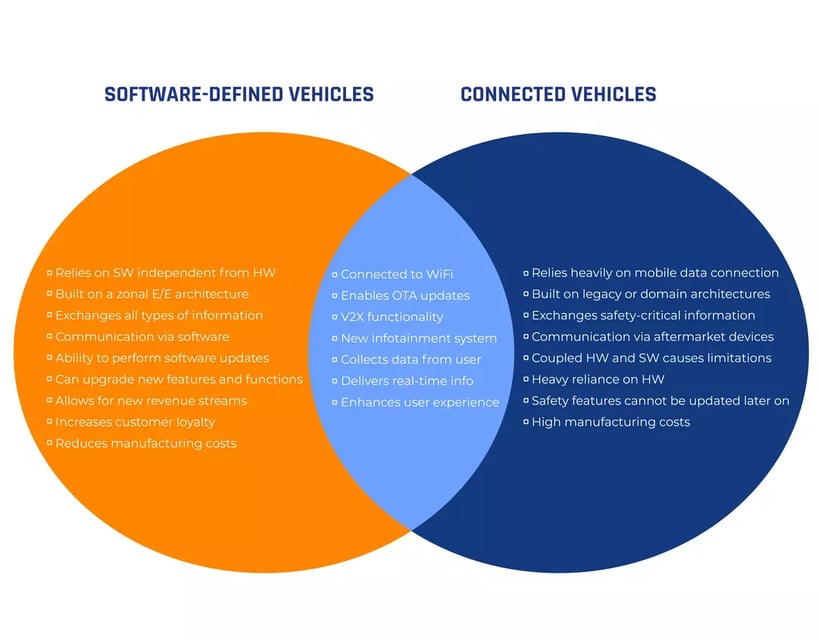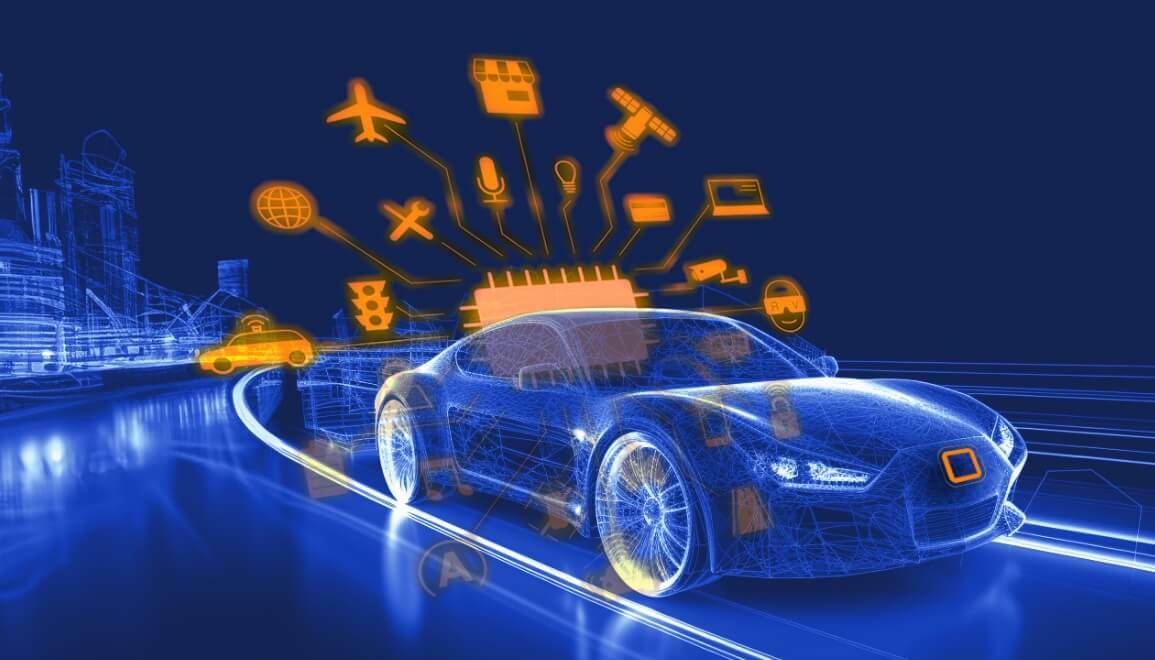1. What Is a Software-Defined Vehicle?
A software-defined vehicle (SDV) is a vehicle that is built primarily on software and where the functions of the vehicle are driven by software instead of hardware. In addition, the vehicle’s software plays a key role in enhancing existing features and introducing new capabilities, allowing for customization of the vehicle without changing the underlying hardware. The SDV signifies a major shift in the automotive world, moving from traditional cars with hundreds of ECUs and hardware-based features to the smartphone on wheels that can be updated and improved over time.
The rise of the SDV is a result of three automotive trends leading the paradigm shift: electrification, automation , and connectivity. These trends answer the needs of modern drivers and result in a renewed OEM-consumer relationship.
Key Benefits for Automotive Manufacturers:- Revenue Growth Potential: With the ability for real-time and OTA updates, SDVs present opportunities for new revenue streams through subscription-based services and ongoing upgrades. Recurring OTA updates also eliminate the need for expensive recalls.
- Competitive Differentiation: SDVs provide a platform for innovative features that can set a brand apart in a highly competitive market, offering value propositions that resonate with the modern consumer.
- Operational Efficiency: SDVs streamline the vehicle development process, reducing R&D cycles and time to market for new offerings.
- Customer Loyalty: Software updates and customized features engage customers while generating greater trust towards the OEM.
2. What are the challenges of software-defined vehicles?
The key challenges that the automotive industry will face as it transitions to software-defined vehicles are:
- E/E Architecture: The new generation of vehicles will rely on and produce huge amounts of data that cannot be handled efficiently by the existing architecture used in traditional vehicles. SDVs will require next-generation Zonal E/E Architecture that can provide the required seamless in-vehicle communication while reducing latency.
- Safety and Security: As more software is introduced into vehicles, there are more opportunities for hackers to attack, putting the safety of drivers and passengers at risk. Developers of SDVs must focus on creating cars that are secure by design to keep drivers and passengers safe, protect personal data and information, and ensure that the vehicle operates as intended.
- In-Vehicle Networking: For an SDV to operate efficiently, the different components must be able to communicate with each other quickly and effectively. Low latency and high bandwidth capabilities are imperative, along with the ability to balance power, manage heat, optimize storage, and ensure memory capacity.
- The New Supply Chain: Traditionally, OEMs would acquire ECUs and the relevant software from the same Tier 1, and the software would be made specifically for each ECU. The supply chain for SDVs is different, giving OEMs the freedom to choose from a variety of software providers who must be able to produce software that can work with any type of hardware.
- Decoupling Hardware and Software: In order to best take advantage of the new supply chain and its flexibility, hardware and software abstraction is crucial. This will consolidate the number of ECUs needed and will allow for the customization that customers crave.
3. Why is the automotive industry moving towards SDVs?
The automotive industry is transitioning to SDVs to maximize embedding advanced technologies in vehicles. The move toward SDVs will lead to the following:
- Reduced Manufacturing Costs: With SDVs, functionalities are consolidated into fewer chips, eliminating the need for multiple individually sourced chips and silicon. This will reduce manufacturing costs to 14% of total E/E cost (a 7% overall reduction).
- Accelerated Product Development: Currently, it takes months if not years to roll out new features as the testing and integration process is long and complicated using a monolithic code. With the agility of an SDV, upgrades and new features can be properly tested quickly and then launched securely over-the-air, shortening the time to market to only weeks.
- Changing Driver Demands: Today’s drivers are used to instant gratification and are already embracing the “smartphonization” of their vehicles. SDVs offer a clear way for OEMs to provide drivers with all of the flexibility and personalization they demand.
- Innovation: While the road to fully autonomous vehicles remains long, many of the elements that need to be put in place for SDVs are setting the foundation for the autonomous cars of the future. All of the investments being made today in the technologies and infrastructure changes needed to power SDVs will pay off long into the future as the industry continues to innovate and evolve.
4. What's the difference between a Software-Defined Vehicle and a Connected Vehicle?
A connected vehicle can communicate with other connected vehicles and various IoT devices, such as lights and sensors. These vehicles are able to share location information and provide warnings about upcoming construction zones, traffic, or other hazards in the roads.
Even a traditional non software-defined car can be a connected vehicle as long as it meets the definition above (although SDVs themselves are connected vehicles by definition). The term SDV refers to the fact that this type of vehicle relies on software to control its functions, enhance its features, and introduce new capabilities. Its foundational architecture is different from that of traditional vehicles and is built from the ground up specifically to allow for these functionalities.
5. What's the connection between Software-Defined Vehicles and self-driving vehicles?
Both SDVs and self-driving vehicles can be thought of as cars of the future, with SDVs being the near future and self-driving vehicles to follow. The technology and safety features that are currently being developed to enable SDVs to operate will set the foundation for autonomous driving and perhaps make it possible.
Some of the key elements that define SDVs that are also necessary components for self-driving vehicles include:
- A secure wireless connection that enables the management, control, and configuration of vehicle software remotely.
- The ability for car owners to adjust their vehicle’s software components using manufacturer-approved apps or physical devices.
- Advanced sensors, LiDAR, and other telecommunication connectivity will be crucial for self-driving vehicles to make judgment calls when it comes to traffic lights, navigating intersections, and automatic emergency braking without human interference.
- Detailed location data will enable routing algorithms to operate more securely, enabling self-driving vehicles to navigate urban transportation flows.
6. How are software-defined vehicles disrupting the automotive industry?
SDVs are revolutionizing the automotive industry in a number of ways, including:
- Reduced Production Costs: The more efficient software engineering exemplified by Zonal Architecture and Service-Oriented Architecture have the potential to streamline the entire vehicle production process. The reduced number of ECUs and associated complex wiring harnesses contribute to significantly reduced production costs.
- Simplified Production Process: The uncoupling of hardware and software creates a much more straightforward testing environment. This means faster development, testing, integration, and deployment of new features and upgrades to existing capabilities. This simpler production process leads to a faster time to market, keeping OEMs, Tier 1s, and other software developers competitive.
- New Revenue Streams: OEMs can leverage the opportunities created by SDVs to establish new revenue streams and business possibilities, such as real-time diagnostics, mobile connectivity, and predictive maintenance.
7. What do SDVs enable (for OEMs and Drivers)?
SDVs enable OEMs to:
- More easily differentiate themselves from competitors by introducing new features to the market quickly in response to customer demand.
- Create post-sale revenue streams throughout the vehicle's entire lifespan. Drivers will be able to pay a subscription and access new features automatically as they become available, saving them the hassle and expense of purchasing or leasing a new car.
- Collect huge amounts of data about drivers’ usage habits from onboard sensors. There are numerous opportunities to monetize this data, as well as use it to improve driver safety, offer additional personalized services, and optimize fleet management.
- Create a vehicle app store (similar to the Google Play Store or Apple’s App Store) offering drivers a wide selection of applications ranging from safety enhancements to infotainment.
- Further, develop and enhance customer loyalty by providing a stellar and personalized customer experience.
With the introduction of SDVs, drivers can:
- Benefit from advanced connectivity features, including real-time navigation assistance, automatic accident and safety alerts, predictive maintenance notifications, keyless access, and more.
- Contribute to saving the planet by driving a more fuel-efficient car with reduced emissions.
- Experience a fully-customizable driving experience without compromising on safety.
- Have the ability to reconfigure features and download updates remotely post-purchase. They will not be required to make an in-person appointment or return to the dealership for most issues.
8. How will SDVs change mobility?
The move to SDVs is changing the automotive industry’s entire approach to vehicles, as drivers come to expect their vehicles to become an integral part of their digital lives.
The change for key players in the automotive industry - including OEMs and Tier 1s - will include:
- Increased partnerships between automotive companies and tech companies, as well as infrastructure providers. These partnerships will enable the seamless development of vehicles powered by software and connectivity.
- An ongoing push for new innovations led by customer demand and boosted by changes and improvements in technology. The SDV architecture lends itself to accelerated development and deployment of new features and innovations, reducing the time to market.
- An array of post-production and post-sale revenue streams, including over-the-air updates and other subscriptions.
- A focus on the collection and monetization of data, including through targeting advertising.
- Reduced production costs overall due to the introduction of central ECUs and the resulting decrease in complex wiring and other infrastructure.
- A new and increased focus on cybersecurity and data privacy with an emphasis on creating vehicles that are secure by design.
The significant changes that drivers will see include:
- A more personalized experience tailored to specific needs. This can include everything from the colors of the car’s exterior to infotainment options to the automatic adjustment of certain elements the moment the driver unlocks the door.
- Improved driving efficiency and safety utilizing V2X (vehicle-to-everything) communication. This next-gen safety technology enables vehicles to communicate with the surrounding environment to provide early warnings against dangers the driver may be unable to see.
- Reduced congestion due to more efficient traffic flows will also result in fewer emissions and increased sustainability.
- A potential shift from car ownership to shared vehicles, especially as it can be easy to customize the experience for each individual driver.
- Improved vehicle performance over its lifetime as new features are added, including new opportunities for in-car entertainment.
Interested in learning how GuardKnox's products help OEMs bring SDVs to market? Click here to get in touch.






